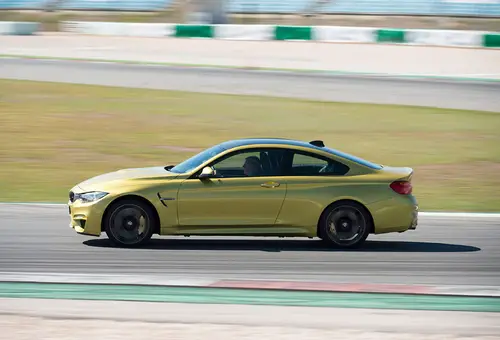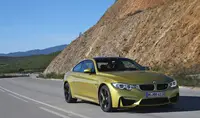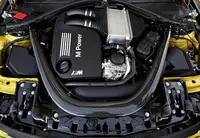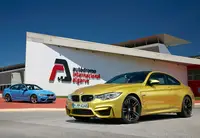Fabulous First Drive Review (170MPH): BMW M3 and M4 by Henny Hemmes +VIDEO
 BMW M4 Coupe |
The new M variants are thrilling machines, developed for the track, but emminently suitable for active driving on open roads
By Henny Hemmes
Senior European Editor
The Auto Channel
• SEE ALSO: BMW Buyers Guide
 BMW M4 |
FARO, Spain - May 9, 2014: In just over a quarter of a century, the BMW M3 has become an icon with a large fan base. Shortly after the introduction of the new 3-Series it was clear that the sedan and coupe were going to be defined by an odd and even number, thus the 3 Series sedan and the 4 Series coupe. It speaks for itself that this also applies to the M variants.
 BMW M4 |
Fans were worried, when M GmbH announced that the upcoming new M3/M4 would also mark the return of the inline six, instead of the use of the V8 that powered the outgoing fourth generation. Would the I-6 be a worthy successor to the mighty V8?
Well, they can rest easy. The new power plant is such an impressively powerful machine that I’m convinced they don’t have to yearn for the extra two cylinders. The potential of the new 431 hp strong 3.0-liter TwinPower TwinTurbo engine was already obvious when I rode shotgun for a couple of laps in an M4 prototype with DTM race car driver Martin Tomzcyck last summer - even though we only knew the torque was ‘more than 500 Nm/ 369 pound-feet.
• SEE ALSO: Henny's first look at the new M4 Coupe
During my very first stint at the helm of the Austin Yellow M4 that feeling came true. Together with my colleague Ian Kuah, I drove to the Autodrómo Internacional Algarve on a stretch of motorway that fortunately was quite deserted. This was our chance for a high speed test!
Watch the BMW M4 and M3 launch video
 BMW M3 sedan and M4 coupe |
Wow, the car accelerates like a jet fighter as soon as you hit the throttle thanks to the 550 Nm/ 405 lb-ft of torque that is available from just 1,850 all the way through 5,500 rpm. We reached 250 km/h (approx.. 150 mph) and were surprised that we saw the needle of the odometer go on and hit 275 km/h, or 170 mph. Probably the electronically limited top of 250 km/h was temporarily lifted? Anyway, even at this speed you always are in control, as the M4 feels like glued to the road. The car is absolutely stable and bumps are hit and smoothed out in a hard way. This was no real surprise, as we had already seen in a display that the chassis of the M3/M4 – indeed they are technically identical – has a very stiff construction.
Up front, the light weight aluminum construction of the components, such as control arms, wheel carriers and axle sub frames saves 5 kilograms/11 pounds over a conventional steel design. The rear-axle sub frame is rigidly bolted to the body structure, while and the new five-link rear axle is around three kilograms/6.6 pounds lighter than the construction of the outgoing M3.
The BMW engineers have worked together with their colleagues at Michelin to develop high performance tires that match the suspension and offer optimum steering feel and precision, good braking qualities, and traction. The M3/M4 leaves the factory on special low weight 18-inch wheels with Michelin Pilot Super Sport in the size 255/40 ZR 18 up front and 275/40 ZR 18 in the rear. However, our test cars were equipped with the optional 19 inch wheels with 255/35 respectively 275/35 rubber.
On the race track, it is easy to go fast as the M4 – as well as the M3 – immediately show the ability to conquer the fast and slow bends with a huge amount of grip. The electro mechanical power steering provides great feed back and precision when turning in. The nose happily turns into corners thanks to the M limited slip differential that opens up and reduces the lock-up of the rear axle.
Watch the BMW M4 and M3 on the track at Ascari Race Resort
The engine and the (optional) M Double Clutch Transmission work optimally together. Some corners may invite you to shift into 2nd gear, but with the huge amount of torque, most of them can be hit in 3rd. Paddle shifting is absolutely the most efficient way of working with the transmission, as it barely requires thinking.
 BMW M4 |
The M3/M4 always starts in default mode, but except from adjusting everything by means of the separate switches at the left side of the shift handle, you can use the M1 and M2 buttons on the steering wheel. In M1, steering and damping are switched in comfort mode, while retaining the sport mode form engine and transmission. In M2, damping goes into Sport with VDC (variable damping control), while engine and steering go into Sport+ , is MDM activated and DSC disengaged, but remains stand-by in case of emergency. The transmission management is switched into the so-called S3 Sport mode, which means that shifts are some 40 per cent faster. In that case you also feel the shift points of the double clutch transmission.
• SEE ALSO: Special inside look at the 2014 BMW M4 technology.html
Even with MDM engaged, the M4 can be easily forced into a drift and as easily taken back in line again. I felt that the M3 showed the same character. This is not so surprising, as both variants only differ by body (the M3 sedan also has a CFRP roof).
The trunk lid of the M4 is of CRFP, while the M3 trunk lid is steel. This was because the weight of the M4 had to be further reduced to make up for the extra 40 kg/ 88 lbs. of the double clutch transmission. The M3 has a curb weight of 1520 kg/3351 lbs, while that of the M4 is 1497 kg/3300 lbs.
On the track you may get the impression that the M4 is lighter, but that may be because you are feeling more enclosed, more one-with-the-car.Asking which model is faster is not really a fair question; you’d really need to drive more laps and use a stop watch in order to be able to time the difference. However, BMW says that the acceleration time from zero to 62 mph is 4.1 seconds for the M4 with 7-speed M DCT, and 4.3 seconds with the 6-speed stick shift.
On the road we go back to the sweeter set up in Sport and enjoy the M4 on the winding route that has been used for the Rally of Portugal. At this point, we don’t need to try and race our car back to the hotel. Our time at Autódromo told us everything we need to know…Still, we would have liked to stay a few more days!
The base price of the BMW M3 is $ 62,200; the M4 is $ 64,200, and destination and handling is an additional $925. To get the specs of our test car, you should add the M DCT double clutch automatic ($2,900), the carbon-ceramic brakes ($8,150) and the 19-inch aluminum wheels another ($1,200). Oh and I should not forget to mention the mileage, that is considerably lower than that of the outgoing M models with the V8. With the six cylinder the average fuel consumption is 8.8/8.3 liter/100 km for the combined EU Cycle ( 6-speed manual/ DCT automatic respectively), which translates into an average of 27.7 and 28.3 mpg.


